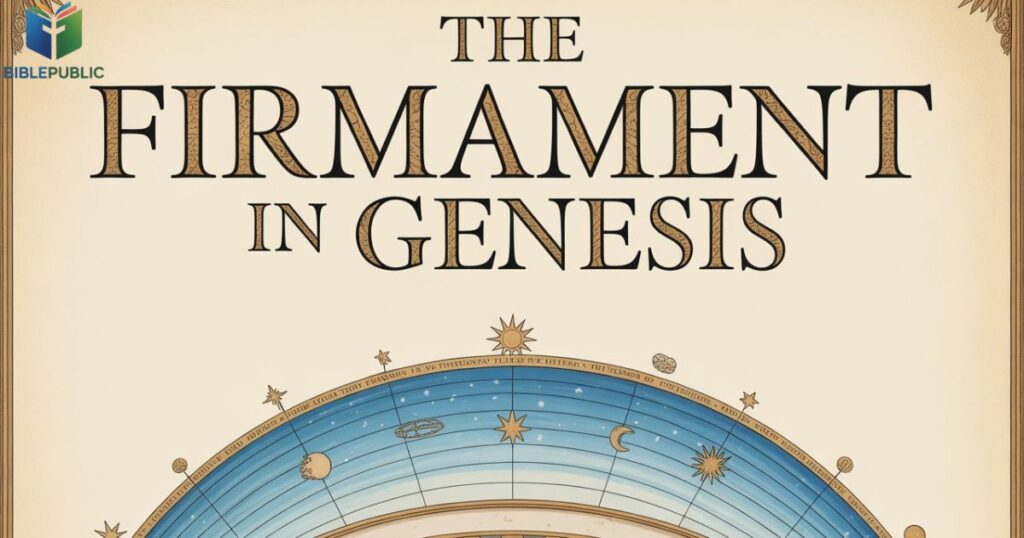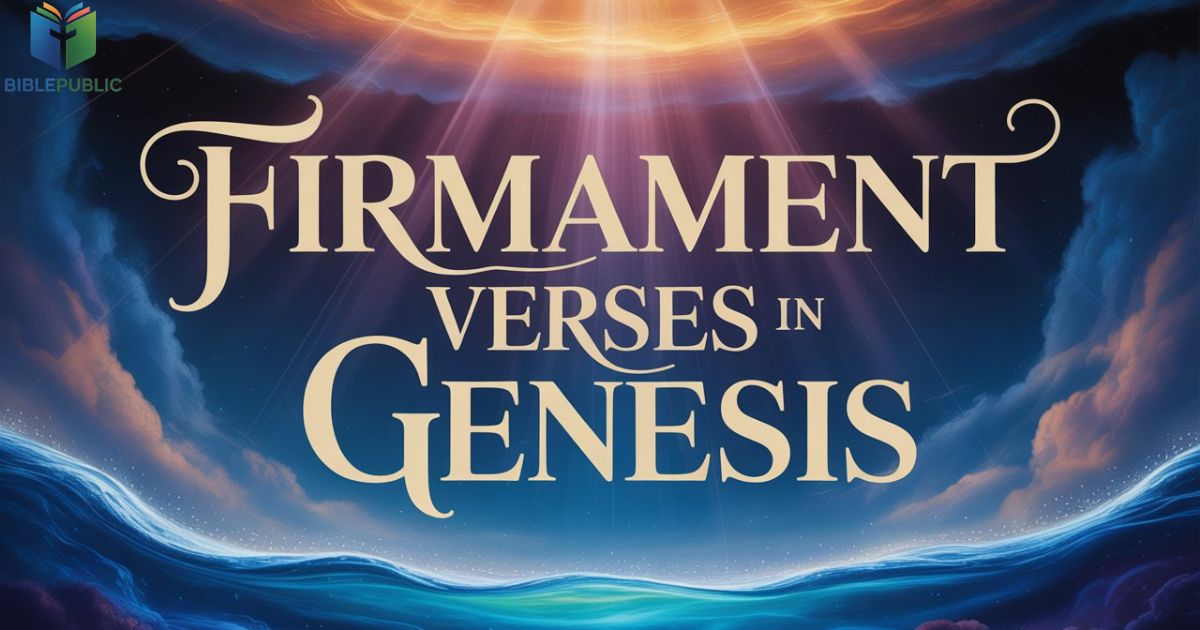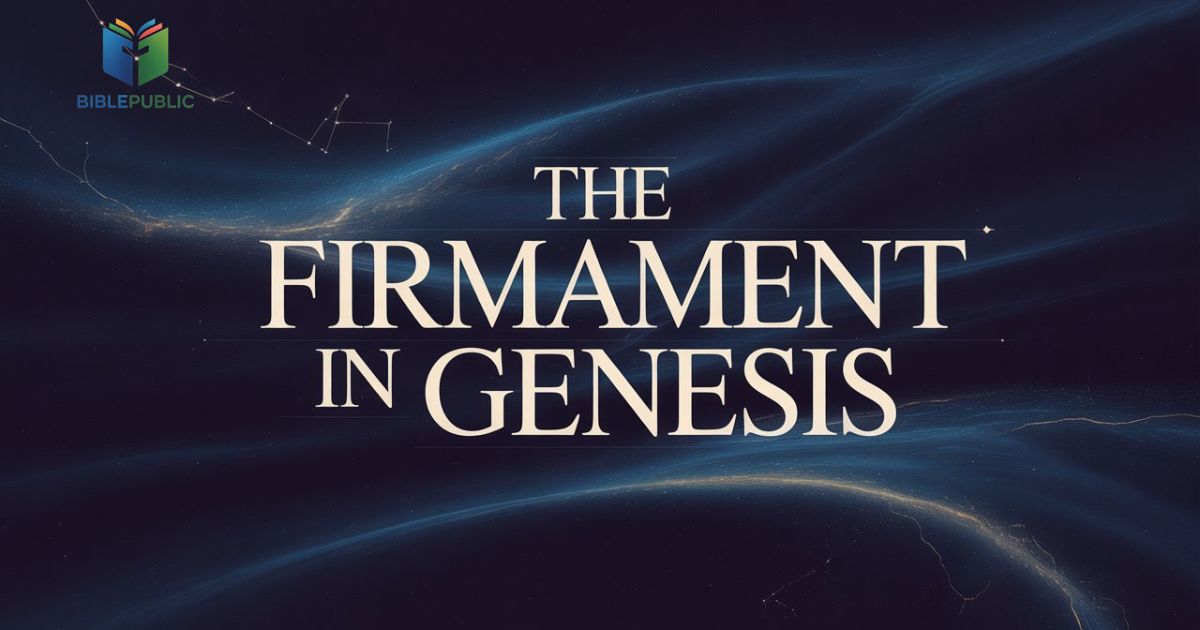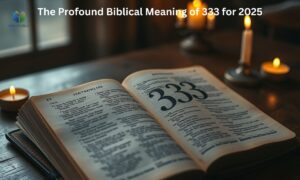The firmament in Genesis stands as one of the Bible’s most debated cosmological concepts. When God declared, “Let there be a firmament,” He initiated a divine act of separation that would shape ancient Hebrew understanding of the universe. This mysterious expanse described in Genesis 1:6-8 divides the waters above from the waters below, creating a structured cosmos from primordial chaos.
But what did the original Hebrew term “raqia” actually mean to its ancient audience? Exploring the firmament in Genesis requires examining ancient Near Eastern worldviews and the theological implications of this creation narrative. By understanding this celestial structure, we gain profound insights into biblical cosmology and God’s intentional design for His creation.
What Is the Firmament? A Biblical Definition

The firmament in Genesis emerges as God’s structured division separating waters above from waters below. Genesis 1:6-8 reveals this dome-like expanse establishing Heaven itself, showcasing divine authority through intentional celestial architecture.
Understanding this heavenly expanse transforms our perception of God’s creative process. The Hebrew word “raqia” means something stretched or hammered thin, suggesting ancient readers envisioned a firm, tangible barrier governing atmospheric phenomena.
The Hebrew Word “Raqia” and Its Meaning
The Hebrew “raqia” derives from “raqa,” meaning to beat or spread forcefully. This suggests something solid yet expansive like hammered metal sheets reflecting substantial divine craftsmanship.
The Firmament in Ancient Hebrew Cosmology
Ancient Hebrews envisioned a three-tiered universe: waters below, habitable Earth, and cosmic waters held by a solid dome above, emphasizing God’s sovereignty.
The Firmament in the Genesis Creation Account
Day Two stands uniquely alone without God declaring it “good” , an intriguing observation worth contemplating deeply. On this pivotal day, the firmament in Genesis took shape through divine proclamation, accomplishing the separation of waters with absolute precision. This was not merely atmospheric formation or cloud arrangement. Rather, God established boundaries defining realms and creating habitable space for future life. The Genesis creation account reveals systematic progression: darkness to light, then water division establishing frameworks. Each creative act built upon previous foundations methodically.
Subsequently, God called the firmament Heaven, conferring identity and purpose upon this expanse immediately. This nomenclature signifies more than geographical designation or spatial reference alone. Heaven shamayim in Hebrew became the realm where birds would soar and celestial bodies would shine. The structured division allowed life-supporting conditions to emerge systematically thereafter. Through this divine order, God demonstrated His meticulous planning and sovereign control over creation. Every element served intentional purposes within His grand design for existence.
Table: The Six Days of Creation and the Firmament’s Role
| Day | Divine Action | Firmament Connection |
| Day 1 | Light created | Foundation for visible realm |
| Day 2 | Firmament formed | Waters divided; Heaven named |
| Day 3 | Land and vegetation | Below the firmament |
| Day 4 | Sun, moon, stars placed | Positioned in the firmament |
| Day 5 | Sea creatures and birds | Birds fly in firmament’s expanse |
| Day 6 | Land animals and humanity | Observers of the firmament above |
Day Two of Creation: Dividing the Waters

Something remarkable transpired when God uttered, “Let there be a firmament”—order from chaos materialized instantly. The primordial waters above and waters below required separation for livable conditions to exist properly. This divide the waters command wasn’t gradual evolution or random chance whatsoever. Instead, instantaneous obedience to divine speech brought structure where confusion previously reigned. The separation of waters established vertical organization within the cosmos systematically. This foundational act enabled subsequent creative developments throughout the remaining creation days.
The Firmament’s Role in God’s Creative Design
Examining God’s creative process reveals intentional sequencing rather than haphazard experimentation or trial-and-error approaches. The firmament in Genesis served multiple critical functions within the ordered cosmos simultaneously. First, it provided atmospheric conditions necessary for terrestrial life to flourish eventually. Second, it established a spatial framework for celestial bodies placement on Day Four. Third, it demonstrated God’s sovereignty over natural forces and elemental powers completely. Furthermore, this heavenly expanse showcased divine wisdom in balancing cosmic forces perfectly. Every component worked harmoniously within His overarching plan for creation.
The Relationship Between Heaven, Earth, and the Firmament
Understanding the tripartite relationship between realms illuminates biblical cosmology profoundly and meaningfully. God called the firmament Heaven, establishing it as the boundary between worlds the terrestrial and the transcendent. Earth existed below, grounded and solid for human habitation and animal life. Above stretched the visible sky where atmospheric phenomena occurred and birds navigated freely. Yet beyond that expanse, ancient believers understood even higher heavens existed in God’s throne room. This vertical hierarchy emphasized the connection to eternity and physical and spiritual realms simultaneously. Heaven became both observable firmament and unreachable divine dwelling simultaneously.
Biblical References to the Firmament
Scripture repeatedly references this heavenly expanse across multiple books and genres. The firmament in Genesis isn’t isolated; prophets, psalmists, and apocalyptic writers acknowledged this celestial feature, demonstrating a unified biblical worldview regarding divine architecture.
Each firmament reference carries distinct theological weight worth exploring. Some passages describe physical properties straightforwardly; others employ it metaphorically to convey spiritual truths about God’s sovereignty, inviting contemplation of cosmos and Creator alike.
Table: Key Biblical References to the Firmament
| Scripture Reference | Context | Key Description |
| Genesis 1:6-8 | Creation narrative | God creates the expanse to divide the waters |
| Genesis 1:14-17 | Day Four creation | Sun, moon, and stars placed in the firmament |
| Genesis 1:20 | Day Five creation | Birds fly across the face of the firmament |
| Psalm 19:1 | Worship declaration | “Heavens declare glory; firmament shows handiwork” |
| Psalm 150:1 | Praise anthem | “Praise Him in His mighty firmament” |
| Ezekiel 1:22-26 | Prophetic vision | Expanse above cherubim, crystal-like appearance |
| Ezekiel 10:1 | Temple vision | Throne above the expanse over cherubim |
| Daniel 12:3 | Eschatological prophecy | Wise shine like brightness of the firmament |
Firmament Verses in Genesis

Genesis creation account establishes the expanse’s foundational purposes, positioning it as integral to habitable world formation and divine cosmic order.
Key Genesis References:
- Genesis 1:6-8 introduces the firmament concept during the second day of creation
- Genesis 1:14-19 positions celestial bodies within this expanse for marking time and seasons
- Genesis 1:20 describes birds flying across the firmament’s face, emphasizing its atmospheric dimension
Firmament Verses in Psalms
Poetic literature transforms the firmament into a worship catalyst, revealing God’s glory through observable creation and sacred celestial space.
Key Psalm References:
- Psalm 19:1 declares “The heavens declare the glory of God; the firmament shows His handiwork”
- Psalm 150:1 summons worshipers to “Praise God in His sanctuary; praise Him in His mighty firmament”
Firmament References in Other Old Testament Books
Prophetic literature employs firmament imagery for theological instruction, conveying God’s sovereignty and transcendent glory beyond human comprehension.
Key Prophetic References:
- Ezekiel 1 and 10 describe a crystal-like expanse above heavenly beings as throne platform
- Daniel 12:3 promises the righteous will “shine like the brightness of the firmament”
Firmament Verses in 2 Esdras (Apocrypha)
Apocryphal literature extends firmament theology into the Second Temple period, revealing ancient Jewish understanding of biblical cosmology themes.
Key Apocryphal References:
- 2 Esdras references the expanse within apocalyptic visions and eschatological discussions
- These texts demonstrate continuity with canonical writings while expanding theological interpretation
Historical and Theological Interpretations of the Firmament
Throughout church history, scholars wrestled with the firmament in Genesis interpretation. Ancient views differed from modern perspectives due to scientific advancement, revealing how cultural context shapes biblical understanding.
Interpretive evolution demonstrates Christian intellectual engagement with Scripture and science. Early Church Fathers harmonized biblical text with available cosmological theories, while modern views incorporate astronomical discoveries respecting theological integrity.
Ancient Jewish Understanding
First-century Jewish communities viewed the firmament as literal physical reality, connecting it with God’s throne room and restrained primordial chaos.
Early Church Fathers’ Perspectives
Patristic writers like Basil and Augustine navigated between scriptural authority and Hellenistic cosmology, balancing literal meaning with theological depth.
Medieval Christian Interpretation
Medieval scholastics integrated Aristotelian cosmology with biblical cosmology, viewing the firmament through crystalline spheres framework as ordered cosmos.
Modern Scholarly and Scientific Views
Contemporary scholarship recognizes “raqia” reflected ancient Hebrew cosmology, seeking faithful interpretation honoring both textual meaning and contemporary knowledge.
The Spiritual Significance of the Firmament
Beyond cosmological debates, the firmament in Genesis carries profound spiritual significance. This heavenly expanse invites contemplation of God’s sovereignty over creation, witnessing continuous testimony to divine order.
The firmament symbolizes boundaries between worlds, reminding us of connection to eternity beyond earthly existence. Psalm 19:1 transforms ordinary sky-gazing into worship-filled meditation on the Creator’s presence.
The Firmament as a Testament to God’s Sovereignty
The firmament powerfully demonstrates God’s sovereignty over natural forces. Cosmic waters submitted instantly to divine decree, establishing ordered cosmos from formlessness.
Lessons on Divine Order and Structure
The firmament established boundaries and organized elements during second day of creation, teaching that healthy boundaries are divine design serving specific functions.
Symbolic Meaning in Christian Theology
Christian theology employs the firmament symbolically, representing veil between temporal and eternal. This heavenly expanse becomes sacramental—material reality conveying spiritual truth.
Common Questions About the Firmament
Curiosity about the firmament in Genesis generates numerous questions from Bible students and skeptics. Does Scripture teach flat earth cosmology? Can biblical cosmology coexist with modern astronomy peacefully?
Honest engagement demonstrates confidence in Scripture’s enduring truth. The firmament invites exploring how ancient peoples expressed theological truths through available cultural frameworks, deepening appreciation for biblical significance.
Does the Firmament Support a Flat Earth View?
The firmament doesn’t mandate flat earth belief. Ancient Hebrew cosmology employed phenomenological language describing appearances, revealing God’s character over providing scientific textbooks.
How Do Science and Scripture Reconcile?
Harmonizing biblical cosmology with modern science requires careful interpretation. Science describes physical mechanisms; Scripture reveals divine purposes, pursuing truth from complementary angles.
Why Is the Firmament Important for Christians Today?
The firmament reveals God’s intentional design and creative process foundational to faith. Understanding biblical cosmology enriches appreciation for Scripture’s ancient Near Eastern context.
Conclusion
The firmament in Genesis offers us a window into how ancient believers understood God’s creative work. It shows us that God brought order to chaos and established boundaries in the universe. Whether we see it as literal or symbolic, the message remains clear: God is sovereign over all creation. This ancient text still speaks to us today about divine power and intentional design.
As we study the firmament, we learn to appreciate both Scripture’s cultural context and its timeless truths. The heavens continue declaring God’s glory, just as they did thousands of years ago. Understanding the firmament deepens our faith and enriches our biblical knowledge. Most importantly, it reminds us to look up with wonder at the Creator’s magnificent handiwork displayed above us every single day.
Frequently Asked Questions
What is the firmament according to the Bible?
The firmament is a dome-like expanse created by God on the second day of creation to separate the waters above from the waters below, establishing the heavens.
Is there a Bible verse about the firmament?
Yes, Genesis 1:6-8 introduces the firmament, and it’s also mentioned in Psalm 19:1, which states “the heavens declare the glory of God; the firmament shows His handiwork.”
What is above the firmament in the Bible?
According to ancient Hebrew cosmology, the waters above (cosmic waters) are held back by the firmament, representing primordial chaos restrained by God’s divine power.
How many times is the firmament in the Bible?
The firmament is mentioned multiple times throughout Scripture, appearing in Genesis, Psalms, Ezekiel, Daniel, and other Old Testament books in various theological contexts.
When did God break the firmament?
The Bible doesn’t describe God “breaking” the firmament, though Genesis 7:11 mentions “windows of heaven” opening during Noah’s flood, allowing waters above to pour down upon the earth.

Mark, founder of BiblePublic.com, shares inspiring insights on the Bible, blessings, and prayer. His mission is to encourage faith, deepen understanding, and help others walk closely with God daily.









